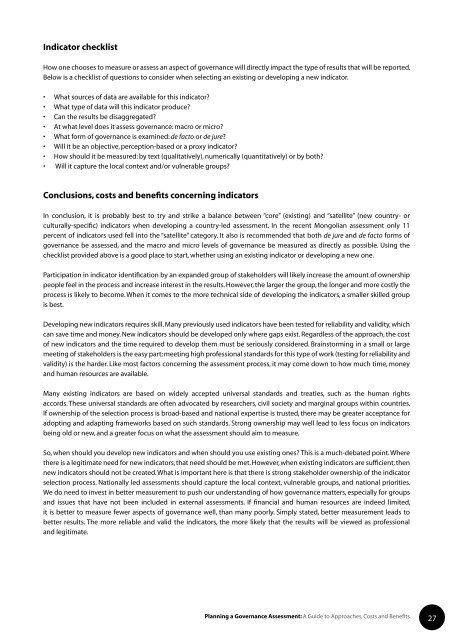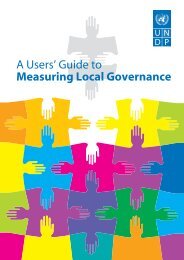planning a governance assessment - United Nations Development ...
planning a governance assessment - United Nations Development ...
planning a governance assessment - United Nations Development ...
You also want an ePaper? Increase the reach of your titles
YUMPU automatically turns print PDFs into web optimized ePapers that Google loves.
Indicator checklist<br />
How one chooses to measure or assess an aspect of <strong>governance</strong> will directly impact the type of results that will be reported.<br />
Below is a checklist of questions to consider when selecting an existing or developing a new indicator.<br />
• What sources of data are available for this indicator?<br />
• What type of data will this indicator produce?<br />
• Can the results be disaggregated?<br />
• At what level does it assess <strong>governance</strong>: macro or micro?<br />
• What form of <strong>governance</strong> is examined: de facto or de jure?<br />
• Will it be an objective, perception-based or a proxy indicator?<br />
• How should it be measured: by text (qualitatively), numerically (quantitatively) or by both?<br />
• Will it capture the local context and/or vulnerable groups?<br />
Conclusions, costs and benefits concerning indicators<br />
In conclusion, it is probably best to try and strike a balance between “core” (existing) and “satellite” (new country- or<br />
culturally-specific) indicators when developing a country-led <strong>assessment</strong>. In the recent Mongolian <strong>assessment</strong> only 11<br />
percent of indicators used fell into the “satellite” category. It also is recommended that both de jure and de facto forms of<br />
<strong>governance</strong> be assessed, and the macro and micro levels of <strong>governance</strong> be measured as directly as possible. Using the<br />
checklist provided above is a good place to start, whether using an existing indicator or developing a new one.<br />
Participation in indicator identification by an expanded group of stakeholders will likely increase the amount of ownership<br />
people feel in the process and increase interest in the results. However, the larger the group, the longer and more costly the<br />
process is likely to become. When it comes to the more technical side of developing the indicators, a smaller skilled group<br />
is best.<br />
Developing new indicators requires skill. Many previously used indicators have been tested for reliability and validity, which<br />
can save time and money. New indicators should be developed only where gaps exist. Regardless of the approach, the cost<br />
of new indicators and the time required to develop them must be seriously considered. Brainstorming in a small or large<br />
meeting of stakeholders is the easy part; meeting high professional standards for this type of work (testing for reliability and<br />
validity) is the harder. Like most factors concerning the <strong>assessment</strong> process, it may come down to how much time, money<br />
and human resources are available.<br />
Many existing indicators are based on widely accepted universal standards and treaties, such as the human rights<br />
accords. These universal standards are often advocated by researchers, civil society and marginal groups within countries.<br />
If ownership of the selection process is broad-based and national expertise is trusted, there may be greater acceptance for<br />
adopting and adapting frameworks based on such standards. Strong ownership may well lead to less focus on indicators<br />
being old or new, and a greater focus on what the <strong>assessment</strong> should aim to measure.<br />
So, when should you develop new indicators and when should you use existing ones? This is a much-debated point. Where<br />
there is a legitimate need for new indicators, that need should be met. However, when existing indicators are sufficient, then<br />
new indicators should not be created. What is important here is that there is strong stakeholder ownership of the indicator<br />
selection process. Nationally led <strong>assessment</strong>s should capture the local context, vulnerable groups, and national priorities.<br />
We do need to invest in better measurement to push our understanding of how <strong>governance</strong> matters, especially for groups<br />
and issues that have not been included in external <strong>assessment</strong>s. If financial and human resources are indeed limited,<br />
it is better to measure fewer aspects of <strong>governance</strong> well, than many poorly. Simply stated, better measurement leads to<br />
better results. The more reliable and valid the indicators, the more likely that the results will be viewed as professional<br />
and legitimate.<br />
Planning a Governance Assessment: A Guide to Approaches, Costs and Benefits<br />
27








![GuÃa del Usuario ] - Governance Assessment Portal](https://img.yumpu.com/44740603/1/190x253/gua-a-del-usuario-governance-assessment-portal.jpg?quality=85)







